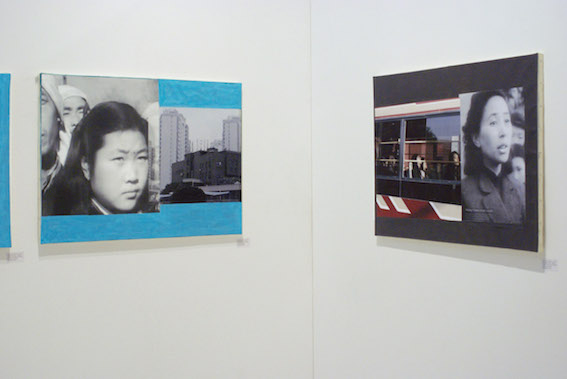Chinesedream




Presentation
"Officials and scholars from around the world offered diverse views of how the Chinese Dream concept championed by President Xi Jinping will benefit the country and the world at the International Dialogue on the Chinese Dream seminar in Shanghai on Saturday. »
(China Daily, December 8th, 2013)
Chinesedream juxtaposes two utopias: the Chinese Dream, an ideology recently created by the Chinese Communist party and modeled after both the American dream and the Maoist dream. Pictures produced in China in 2013 are arranged with documentary images dating back to the Maoist era, approximately between the 1950’s and 1970’s. Juxtaposing these two sorts of images, both in a synchronic and anachronic manner, brings about a contradictory perception, an overlapping of times, of periods and vantage points. In Chinesedream, there is an association of images that could be a collage but isn’t. Rather the effect comes from virtual archiving of facts and of time exposed in a pattern of reciprocal intrusions, and by so doing provoke a desire for history. Chinesedream is also the extension of a series of paintings in the 1990’s by Ezra Nahmad. Some of these canvasses are on exhibit.
PRESS RELEASE
CHINESEDREAM
“Nothing that has ever happened should be regarded as lost for history”
Walter Benjamin
In Chinesedream, there is an association of images that could be a collage but isn’t. Rather the effect comes from virtual archiving. This concept puts photography into a digital environment. Within it are assembled masses of documents along with the right to scrutinize them via tubes, the overall monitoring, all of which change the nature of photography.The image of a tube is used to describe the digital flow that depicts the fluid, yet agitated, style of existence, of shadowy journeys, of recurring, uninterrupted signs. The tracking and the shadowing of information in digital space reinforce suspicions about photographs and transforms their silver print moment into a primitive stage of innocence.
Such phenomena, power of the masses, wealth, accelerated dissemination, “peep hole” scrutiny and surveillance calls to mind the huge population, the historic acceleration, and general surveillance that prevail today in China . There is a concomitance even a complicity between the digital revolution and China’s shift to a new capitalism. And it is undoubtedly, in respect to time, to the past, and to history that this coincidence is the most telling. There is no ignorance of nor scorn towards the past but rather an unfolding of a new embryonic historic awareness, a sort of realization of Walter Benjamin’s wish: “Nothing that has ever happened should be regarded as lost for history.”
Digital stocking, in its promise to account for everything that happens, bets on this wish. As far as the Chinese are concerned everything that has come and is to come must be seen in the light of the long period of Maoist amnesia. Because of this censorship they feel they must retrieve all that’s been lost.
China led a revolutionary, modern fight in order to reach its independence in the 20th century. It threw off its feudal yoke and got rid of foreign domination; China experienced violent political strife, almost like civil wars, after its declaration of independence. China moved into the modern world by making a tabula rasa of its past, by placing industrial and economic progress above everything. But these myths of modernity and of revolution didn’t fade from the Chinese horizon with the end of Maoism. They still guide China’s future and that of most nations.
China acquired its independence in October 1949, and a year earlier Israel also became a full fledged state, and though the history of each of these two countries is very different, the conflicts that precede and follow their road to independence are based on identical illusions and dreams of national regeneration, blind faith in technological and industrial progress, scorn for the eradicated old world. The Chinese masses liberated themselves, but their vitality was again quickly pillaged. There is a continuity in Maoist utopia and the Chinese dream of XI Jinping rooted in growth, and the Chinese refuse to evaluate Maoism and to consider its failure. Instead, they both pursue the same objectives but by different means. Chinesedream evokes these historic turnabouts by the urban views, by the lost or wild-eyed looks, by the processions and the cohorts of rural peasants recruited and put into communes, by the red guards, or by the anonymous masses shipped off to the high rises in the Chinese metropolitan areas.
Chinesedream is an improbable rapprochement between rockeries found in traditional Chinese gardens and highrise apartment buildings that line the highways in the middle of nowhere. Could this daring hypothesis about the Chinese imagination explain the new towers as rockeries symbolizing telluric forces in the universe?
The art of Chinese gardening creates an ideal cosmos in miniature; it’s a space designed for greenery, water, paths, and rocks; it mirrors the universe. The rockery evokes the mountains, living skeletons of the earth--an emanation of bony parts of the universe that secure its stability and permanence; all of this sustained by the breath. Undoubtedly, this all goes back to a geomanic tradition or the art of divination by casting earth or stones. The care of the rockery, its arrangement, its lighting and decoration summons an exchange between the finite stone placed on its base with its minute surface details and the mountains, meteorites, or planets.
In the shifting of the scale from the smallest to biggest, from close to afar, the individual comes into contact with cosmic energies. The more that a stone posed vertically in the garden approaches human scale, the more obvious the union between man and nature becomes. If the towers of Shanghai symbolize the force and vitality of Chinese capitalism, the dynamism of such urban growth, the magnetism is comparable to that of rockeries in traditional gardens.
The minerality and the concentration of the towers remind us of mountain ranges, their peaks as high as the spires of gothic churches. They evoke a rising to the sky, a liberation from earthly constraints and gravity. The movements that animate them, geometric mosaics of the facades, circulations of body fluids, scintillating evening lights resemble breaths that cross over the rockeries, symbolizing cosmic forces.
The hypothesis of a permutation of these two objects in the Chinese imaginary is nourished by such similarities. In the same way, rockeries and towers also evoke the idea of construction; they remind us of primitive, telluric sculpture. And this primitivism is well suited to myth and dreams, with the vertigo produced from the scale, the unfolding from the smallest to the biggest which produces a singular headiness.
The binary compositions of Chinesedream, left/right, black and white/color, in front of/ in back of, do not aim solely at engaging a temporal pulse. They set up a spatial scale as well by joining close-ups of faces and urban panoramas in a clear visual discrepancy. This juxtaposition produces a tension between the sensory, visual facts on the one hand, and the social, environmental events on the other--between emotions and acts, of people or groups, of trivial events and historical ones.
These tensions come to life in a conflict of scale where perception, reason, mastery, balance are questioned. L'échelle is first of all an object that moves in the world of geometry, of perspective, architectural design or music. The conjunction of the digital revolution e.g. the proliferation of big data – almost incomprehensible masses of voluminous information – fromhyper-industrialization, from economic and political concentration – makes of the “scale” a social, economic, cultural or environmental object. The place of individuals in a society and in the universe is re-arranged (the “size” of the individual and that of the forces that envelop him/her) as was the case at the end of the Middle Ages or with the industrial revolution. The notion of “scale” is essential in digital photography (the range of the shooting angles from micro to macro--records of vast enlargement. Chinesedream composes with the experience of scale.
Ezra Nahmad

